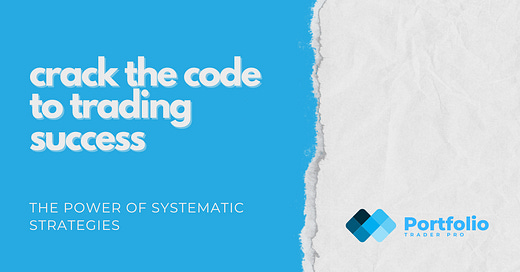Crack the Code to Trading Success: The Power of Systematic Strategies
Discover how data-driven trading can transform your portfolio—consistent wins, smarter decisions, and a strategy that works in any market.
Imagine making trading decisions based on precision, clarity, and confidence—free from the chaos of market noise and emotional whims. This is the power of systematic trading. By relying on predefined rules and data-driven strategies, you can navigate the markets with a clear edge.
Let’s break down what systematic trading is, its key features, advantages, and how you can start implementing it to secure long-term success.
1. Understanding Systematic Trading
Systematic trading is a disciplined approach to trading where every decision is guided by rules and models grounded in data. Unlike discretionary trading, where emotions and intuition often cloud judgment, systematic trading operates on objective, pre-tested strategies.
At its core, it’s a game plan for the markets:
Rules drive decisions instead of speculation.
Strategies are tested to ensure reliability.
Execution is consistent, removing emotional bias.
Systematic trading isn’t about eliminating risk—it’s about managing it intelligently with a structured process.
2. Key Features of Systematic Trading
Every successful systematic trading system has a few common features:
Predefined Rules: Clear entry, exit, and risk management rules ensure consistency.
Data-Driven Decisions: Historical data and real-time market information form the backbone of the strategy.
Automation: Many systematic traders use algorithms to monitor markets and execute trades.
Back-Testing: Strategies are tested against historical data to validate their effectiveness before being deployed in live markets.
These features allow traders to navigate markets systematically, minimizing the impact of human error.
3. Advantages of Systematic Trading
Why adopt systematic trading? Because it puts you in control.
Consistency: With rules in place, every decision follows the same process, minimizing knee-jerk reactions.
Objectivity: Data eliminates emotional bias, ensuring you’re guided by logic, not fear or greed.
Scalability: Systems can scan thousands of opportunities across markets, maximizing efficiency.
Time-Saving: Automation allows you to focus on refining your strategy instead of reacting to every market move.
Risk Management: Predefined stop-losses and position sizes prevent catastrophic losses.
When implemented well, systematic trading can significantly improve your trading outcomes.
4. Implementing a Successful Systematic Trading Strategy
Ready to dive into systematic trading? Here’s how to start:
Step 1: Define Your Objectives
Be specific about your goals. Are you aiming for short-term gains, trend-following strategies, or hedging risk? Your objectives will shape your approach.
Step 2: Develop Your Rules
Identify the indicators, patterns, and signals that will trigger your trades. For example:
Entry rule: Buy when a stock crosses above its 50-day moving average.
Exit rule: Sell when the RSI hits 70.
Step 3: Test Your Strategy
Back-test your rules using historical data to measure performance. Look for metrics like win rates, drawdowns, and profit factors.
Step 4: Manage Risk
Use tools like position sizing, stop-loss orders, and risk per trade limits. Remember, no strategy wins 100% of the time.
Step 5: Start Small
Test your system in a live environment with a small portion of your capital. Refine as needed before scaling up.
Step 6: Optimize Over Time
Markets evolve, and so should your system. Continuously analyze performance and make adjustments where necessary.
5. Systematic Trading: The Key to Long-Term Success
The stock market is unpredictable, but systematic trading offers a way to navigate it with discipline and clarity. It helps you capture opportunities, manage risks, and stay focused on long-term success.
When you adopt a systematic approach, you’re not just reacting to the market—you’re executing a well-thought-out plan designed to thrive in any condition. It’s the ultimate way to take control of your trading journey.
Your Next Step
Have you tried systematic trading before? What’s holding you back? Let’s start a conversation in the comments.
And if you’re ready to dive deeper into systematic trading and data-driven investing strategies, subscribe to this newsletter for more actionable insights delivered straight to your inbox.




